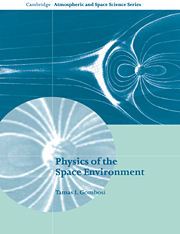Book contents
- Frontmatter
- Contents
- Preface
- Part I Theoretical Description of Gases and Plasmas
- Chapter 1 Particle Orbit Theory
- Chapter 2 Kinetic Theory
- Chapter 3 Basic Plasma Phenomena
- Chapter 4 Fluid and MHD Theory
- Chapter 5 Waves and Oscillations
- Chapter 6 Shocks and Discontinuities
- Chapter 7 Transport of Superthermal Particles
- Part II The Upper Atmosphere
- Part III Sun—Earth Connection
- Appendices
- Bibliography
- Index
Chapter 6 - Shocks and Discontinuities
Published online by Cambridge University Press: 22 October 2009
- Frontmatter
- Contents
- Preface
- Part I Theoretical Description of Gases and Plasmas
- Chapter 1 Particle Orbit Theory
- Chapter 2 Kinetic Theory
- Chapter 3 Basic Plasma Phenomena
- Chapter 4 Fluid and MHD Theory
- Chapter 5 Waves and Oscillations
- Chapter 6 Shocks and Discontinuities
- Chapter 7 Transport of Superthermal Particles
- Part II The Upper Atmosphere
- Part III Sun—Earth Connection
- Appendices
- Bibliography
- Index
Summary
It has been observed under certain conditions that most mediums in the space environment can experience abrupt changes of macroscopic parameters. In a broad sense shocks and discontinuities are defined as transition layers where the state of the fluid changes from one that is near an equilibrium state to a different one. Examples involve detonation waves in the atmosphere, shocks, and transition layers in the magnetosphere, the interplanetary medium, and in the Sun. In all these cases the transition layer is very narrow compared to the characteristic scale of the problem.
In this chapter we consider the fundamental theory of shocks and discontinuities in neutral gases and quasineutral plasmas.
Normal Shock Waves in Perfect Gases
In the perfect gas approximation shock waves are discontinuity surfaces separating two distinct gas states. In higher order approximations (such as the Navier—Stokes equations) the shock wave comprises a region where physical quantities change smoothly but rapidly. In this case the shock has a finite thickness, generally of the order of the mean free path.
Because the shock wave is a more or less instantaneous compression of the gas, it cannot be a reversible process. The energy for compressing the gas flowing through the shock wave is derived from the kinetic energy of the bulk flow upstream of the shock wave.
- Type
- Chapter
- Information
- Physics of the Space Environment , pp. 103 - 112Publisher: Cambridge University PressPrint publication year: 1998



